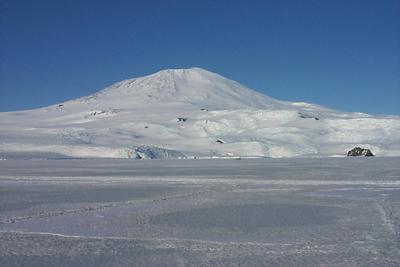28 November, 1999
McMurdo Station, Ross Island, Antarctica
Sunday
Today was Father Bede's last Sunday Mass at Chapel of the Snows! He will be
sorely missed when he leaves on Thursday.
The gas chromatograph (GC) has decided to have a mind of it's own! We
continue to obtain good data, but it is at the expense of long hours and
much improvising. Again, this is what science is all about! How do we get
this instrument to behave with the equipment and supplies at hand? We have
used aluminum foil, a hair dryer, a light bulb, and different techniques for
pulling the gas from the vial into the hypodermic needle! It is
frustrating work and by 9 p.m., it has taken it's toll on you physically and
emotionally! I'm surprised that we still talk to each other after such long
days!
After singing at Mass, I worked on the GC, ate meals, worked on the GC some
more, and at 8:30 p.m. I tried to write journals, but by 9 p.m., I was
making computer errors that put my digital images at risk and so decided to
call it a night!
QUESTION OF THE DAY: How fast does the ice move on the Polar Plateau? The
Polar Plateau is the snow-covered, ice-covered land that covers the South
Pole and surrounding areas. Remember that the South Pole is at an elevation
over 10,000 feet above sea level.
POLAR PROFILE: On this day in 1979, an Air New Zealand DC-10, carrying 257
people, crashed into the side of Mount Erebus, just a few miles from
McMurdo. The plane was part of a 'flightseeing' trip that originated in
Auckland, New Zealand. These trips, giving tourists the opportunity to see
Antarctica, were once very common.
Air traffic controllers lost radio contact with the plane and hoped that it
had made an emergency landing somewhere on the sea ice. No one knew for
certain what had happened to the plane. A rescue mission was organized and
shortly thereafter, a U.S. C-130 (the plane on which I'll fly back to New
Zealand) spotted wreckage on the northeast slope of Mount Erebus. Unable to
land, the C-130 crew reported their findings and soon a Huey helicopter put
three New Zealand mountaineers from Scott Base, at the crash site. They
found no survivors. Only 213 bodies out of the 257 people on board, were
recovered. For this reason, the site has been designated a Special
Protected Area under the Antarctic Treaty. It has been preserved as a tomb
for the 44 people whose bodies still rest on Mount Erebus.
Many years passed before investigators determined that pilot error and
faulty programming of navigational systems, caused the plane to crash in
heavy clouds. The plane was traveling at 300 miles an hour.
Air New Zealand and Qantas Airlines, discontinued the flightseeing trips to
Antarctica. On Thursday of last week, Father Bede and several
representatives from Scott Base, the New Zealand research station on Ross
Island, laid wreaths at the foot of a cross erected at the crash site.
Father Bede also conducted a memorial service at Scott Base today.
Sharon
JUST FOR KIDS!!!!! Have you ever tried to play with a toy and it just would
not do what the commercial said it should do? Today, the gas chromatograph
(GC) would not work the way it was supposed to and I was very frustrated!
Part of being a scientist includes using what you have in your drawers and
cabinets to make everything work as best as it can! We were using aluminum
foil that you would find in your kitchen! We used a hair dryer! We even
used a light bulb to try to fix our problem. The hair dryer worked the
best, but by the time we figured it all out, it was very late. We had
worked all day and it was bedtime and we were still working! I hope that
tomorrow, the GC behaves itself!
QUESTION OF THE DAY: How fast does the ice move on the Polar Plateau? The
Polar Plateau is the snow-covered, ice-covered land that covers the South
Pole and surrounding areas. Remember that the South Pole is at an elevation
over 10,000 feet above sea level.
POLAR PROFILE: On this day in 1979, an Air New Zealand DC-10, carrying 257
people, crashed into the side of Mount Erebus, just a few miles from
McMurdo. The plane was part of a 'flightseeing' trip that originated in
Auckland, New Zealand. These trips gave tourists the opportunity to see
Antarctica.
Air traffic controllers lost radio contact with the plane and hoped that it
had made an emergency landing somewhere on the sea ice. No one knew for
certain what had happened to the plane. A rescue mission was organized. An
U.S. C-130 airplane found the wrecked plane on the side of Mount Erebus.
The crew reported what they had found and soon a Huey helicopter delivered
three New Zealand mountaineers from Scott Base, to the crash site. They
found no survivors. The site has been preserved as a Special Protected Area
because some of the people on the plane were never found.
Air New Zealand and Qantas Airlines do not have the flightseeing trips to
Antarctica anymore. On Thursday of last week, Father Bede and several
people from Scott Base, the New Zealand research station on Ross Island,
laid wreaths at the foot of a cross that was erected at the crash site.
Father Bede also had a memorial service at Scott Base today.
Sharon

Mount Erebus. Photo by Steve Arcone
Contact the TEA in the field at
.
If you cannot connect through your browser, copy the
TEA's e-mail address in the "To:" line of
your favorite e-mail package.
|
